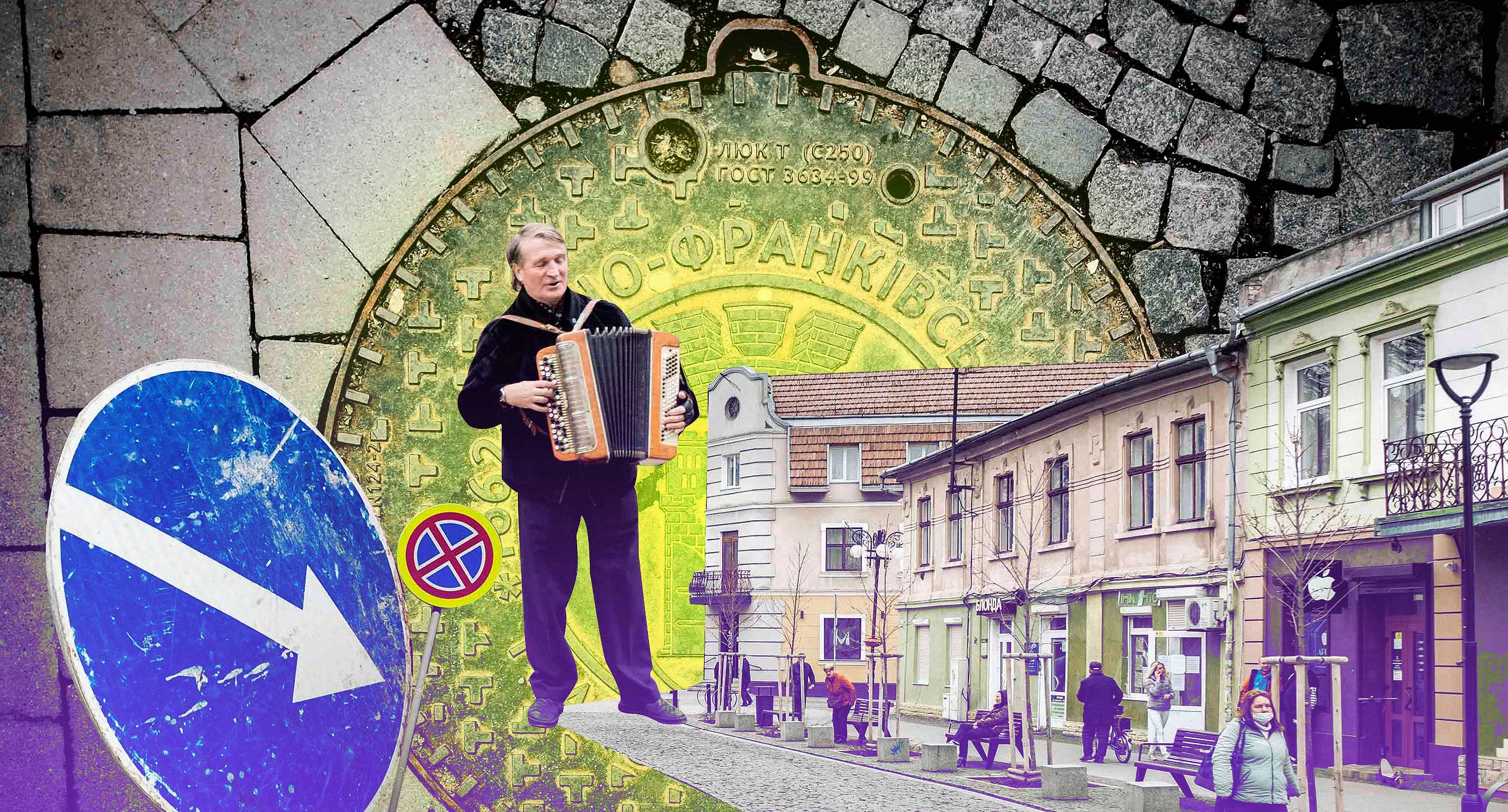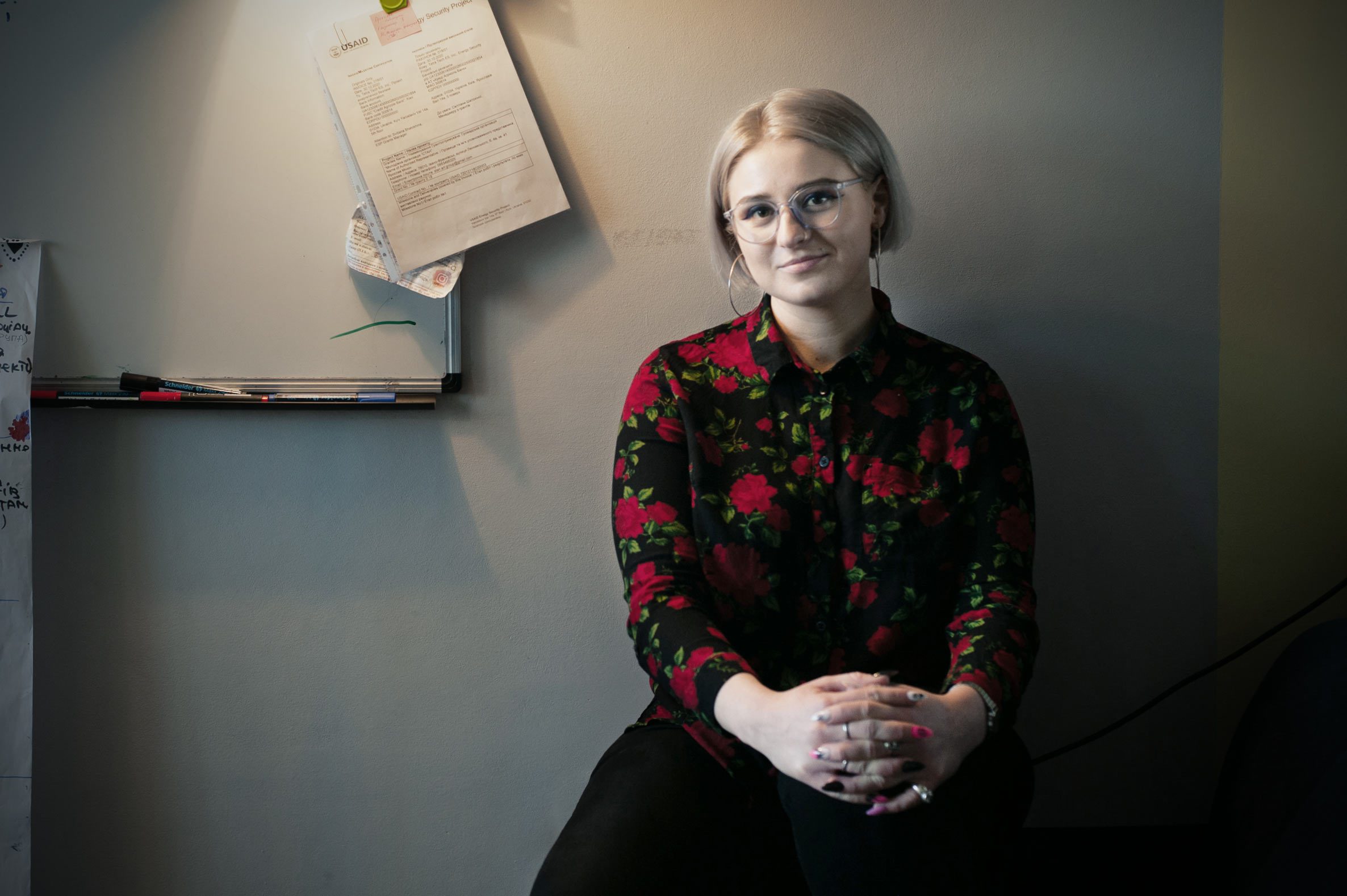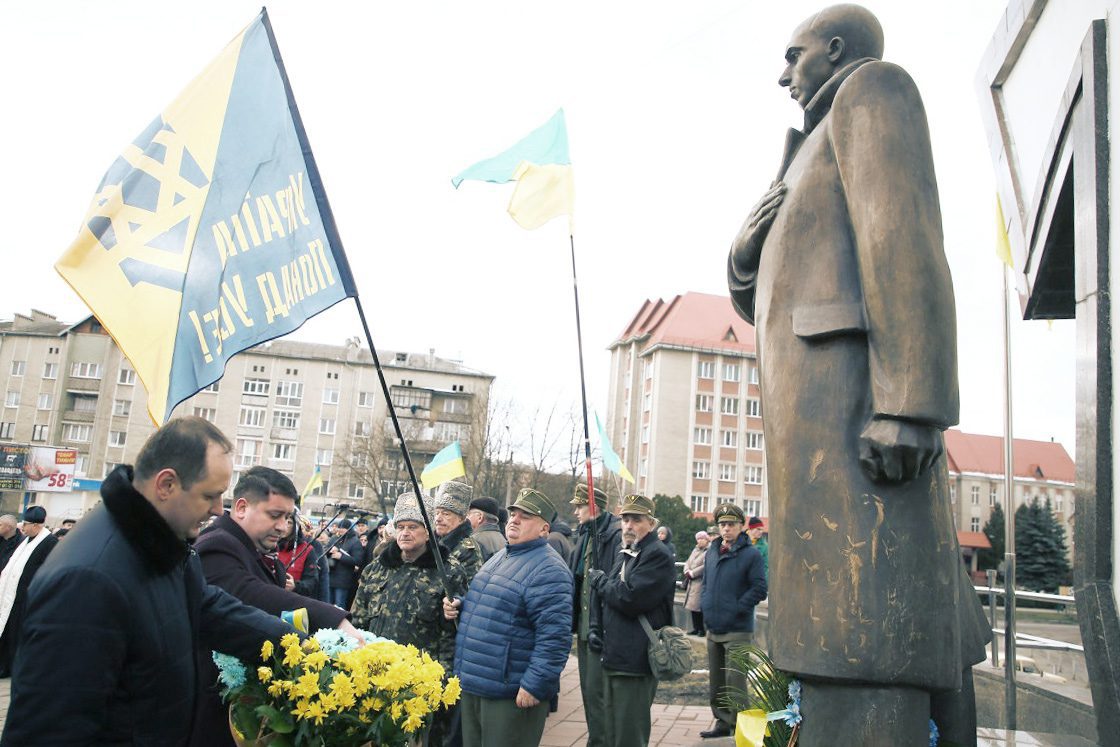For the last few years, people have been talking about Ivano-Frankivsk as one of the most innovative and modern cities in Ukraine. The main examples of the city’s success are located in the city center, including an innovation center built on the premises of the old Prompryland plant where the state, the public, and businesses cooperate, and the publicly-owned restaurant Urban Space 100. Resurfacing the streets and creating public spaces takes the wishes of pedestrians, cyclists, and people with disabilities into account. However, Ivano-Frankivsk still has a long way to go before it is truly a fully inclusive city. Zaborona talks about how Ivano-Frankivsk is changing, and what changes are still lacking.
We met with local activist Ulyana Sydor near one of the hospitals in Ivano-Frankivsk. The city is in the Red Zone: therefore, quarantine measures have been intensified, and ambulances are constantly pulling up to the entrance. But Ulyana is not dealing with coronavirus in the hospital: she is working on inclusivity projects.
“Hospitals are mandatory structures and they must be accessible to everyone,” says Ulyana. “But there are many nuances that we are still working on: we are changing all the ramps because the ones we have are too big, too high, and at the wrong angle. But they are changing it, and if they build new premises, they will already be barrier-free. “

Ulyana Sydor. Photo: Roman Stepanovych / Zaborona
Ulyana has been working on accessibility and inclusivity projects for about ten years. She is from Ivano-Frankivsk, and says that she has always had a desire to change the city for the better. It all started with the installation of audible traffic lights. This helps not only people with visual impairments: Ulyana says that she herself might not pay attention to the traffic light, but always reacts to the sound. This is the essence of inclusivity projects: it turns out that everyone needs and benefits from them.
Fighting for ramps
Not far from the hospital where Ulyana works is a lake which locals often come to. Now, due to the quarantine, there are fewer people there, but in good weather and calmer times, it is one of the favorite places for Ivano-Frankivsk’s residents. Currently, the public space is being redesigned but the deadline has been pushed back because of the quarantine. Ulyana shows us what has already been done: new ramps, bike paths, street simulators.
“After the Soviet Union collapsed, we started noticing a lot of unnecessary things,” says Ulyana. “Extra stairs, uncomfortable ramps. Now they have been changed, and it will be easier for mothers with a stroller to go there because the new ramps are wider. “
New areas are being built near the lake, and several houses are already standing. According to city regulations, all new buildings must be inclusive. But in practice, this is not always the case. In new buildings or even business premises, says Ulyana, ramps are still being made at an angle of 45 degrees and above. Such ramps are curved and simply not suitable for people with disabilities or mothers with strollers.
“People don’t always understand that it’s not just a box to tick,” adds Ulyana. “Now that the building codes have changed, it is necessary to think about ramps, but there are still mistakes being made.”
It is really difficult to fight private businesses, affirms Nazariy Rohiv, the head of the infrastructure policy department of the Ivano-Frankivsk City Council. For example, when opening a store, the owner must build one or more steps in front of the entrance. They could also make the entrance on the same level as the sidewalk, and that would facilitate access for people with limited mobility. “I don’t know, maybe they think that there could be a flood and everyone will be flooded,” he says, perhaps not entirely in jest.

Nazariy Rohiv. Photo: Roman Stepanovych / Zaborona
Compromising with drivers
To get from the lake to the historic city center, you have to go along Mazepa Street. It is partly a pedestrian street and used to have a bike path, but then the sign was removed. People still perceive it as a place for cyclists: the road for cars is much narrower. Nazariy says there is a plan to make it entirely a pedestrian street. But when his department started talking about it, motorists immediately became indignant.
“We had to compromise and just narrow the road, not remove it completely,” says Nazariy. “And now, when people see that it has become more convenient, they propose completely removing the space for cars.”
“The roads are being narrowed and that’s the right thing to do,” adds Ulyana. “A car has only one lane to get where it needs to go. When there are two lanes, especially in the center, and also parking on both sides, cars take up too much space. And children, as a result, do not have room to play in the city center. The city center should be accessible to every resident, who should be able to reach it from anywhere in the city without any obstacles or barriers. “

Photo: Roman Stepanovych / Zaborona
Stometrivka Street is the oldest pedestrian street in Ivano-Frankivsk. Lesya Ukrainka Street is nearby, and local authorities have already been resurfacing it.
“When the project was being developed, activists said that it was worth preserving the historic curbs of Ivano-Frankivsk, which are unique to our city,” says Nazariy. “But we made the street completely barrier-free. So we decided to leave the curbs partly as part of the frame – so that the barriers remain. “
He adds that streams of people constantly pass through the crossroads because it is the tourist center of the city. According to his estimates, there are about 30 thousand people every day – a big number for a small city. Nazariy says that the fact that people come here for a walk is the best indicator that the public space was planned correctly.
Gender security
In 2019, Ulyana Sydor became a participant in the Eastern Partnership Civil Society Facility program. Thanks to it, young people who initiate changes in culture, medicine, social work, media, and other areas receive support from the EU, express opinions on behalf of young people at major international events, and develop their leadership skills. For this program, Ulyana developed a methodology for assessing the safety of public places per the example of Ivano-Frankivsk. The peculiarity of this study is that it takes gender aspects and security into account.

Photo: Roman Stepanovych / Zaborona
“I have developed a methodology with experts for assessing public spaces while also taking safety criteria into account,” says Ulyana. “We used Vienna as an example. They have a department that deals with infrastructure and various other projects. They have developed a whole handbook on how to take different gender criteria and the needs of different users for their own parks, roads, and sidewalks into account. The dimensions of this are very precise: they measured everything and determined how much space it takes for a mother with one or two children to walk comfortably and easily there, even with a bag or a dog. That is, they selected different situations, studied them, and all this is described in great detail and used in their work. “
Gender aspects do not divide the city into conditional spaces for women or men. Ulyana explains that most of the documents used in the planning of public spaces are focused on a very general user profile. Most often, this means the profile used is of a young man, although this is an incorrect approach because men and women feel differently in the same spaces. The same applies to the elderly: the needs of seniors are different, adds Ulyana. If the city focuses on people who have more needs, it will be more comfortable. Conventionally speaking, a space where a woman in a wheelchair feels safe will be safer for other residents as well.

Photo: Roman Stepanovych / Zaborona
“It is easier for women than men to talk about their fears and problems,” says the activist. “But it is important to take them into account. For example, I am a woman, and it is important to me that I see a ‘way out’ in the event of an attack. That is, if I see that the trail has a continuation, then I am calmer, and when I do not know what awaits me behind a house, this subjective fear appears. Men may be afraid of a crowd because they have had some negative childhood experiences – perhaps a fight – and they will remember it. I know many men who refuse to go to concerts, fairs because of the crowds, and are afraid there may be an incident. “
Problems of conservatism
Ivano-Frankivsk has really become much more comfortable than it was 5-10 years ago, says STAN activist Yulia Sinkevych. However, he immediately adds: it is only about inclusion for people with limited mobility and people with disabilities. Other groups, such as Roma or LGBT people, still find it difficult to move around comfortably in the city.

Yulia Sinkevych. Photo: Olesya Saienko
Ivano-Frankivsk, despite modern ideas and solutions, still remains a conservative city. And city authorities only foster these sentiments. On the one hand, the mayor’s office and the mayor himself, Ruslan Martsinkiv, are as open to voters as possible. Officials maintain pages on social networks, where they actively answer questions. The Department of Architecture has created a Facebook group, “Kommunalka” (communal in Ukrainian), which discusses the problems of public spaces. The mayor has successfully built the image of an open person: he walks around the city and talks to citizens. Ivano-Frankivsk residents like it. Ulyana also says that officials are quite willing to cooperate with activists on the design of public spaces, and take their ideas into account.
On the other hand, it is Ruslan Martsinkiv who is the main distributor of anti-Roma and homophobic sentiments in the city. At one meeting, for example, he asked why the Roma were not "packed up" and removed from the train station, a popular gathering point for Roma populations in many Ukrainian cities. However, he later claimed that he had been talking about quarantine violators.
In numerous interviews, Martsinkiv emphasizes that Frankivsk is a Christian and traditional city. He says that “a gay man cannot be a patriot.” He consecrated the Potocki Palace, a 17th century structure, after the performance of the band Hammerman Destroys Viruses, because he considered their performance debaucherous. He’s also blessed elevators in a newly built house.
“He works for his voters,” says Yulia Sinkevych. “The city is really mostly anti-Roma and homophobic. And we have a lot of Roma because of the proximity to the border. And when Martsinkov says something anti-Roma, it becomes even more difficult to work with people. It is even more difficult to overcome the stigma that exists. “
LGBT people, Sinkevich adds, allegedly do not exist in the city at all. It is difficult to hold a Pride March here, but Marches for “Traditional Values" are held regularly. And local parliamentarians are constantly appealing to the president or MPs to "ban gay propaganda."
The STAN team works with such sensitive topics. She conducts training sessions for young activists and entrepreneurs, organizes intercultural dialogues and discussions, helps refugees from Belarus and other countries with authoritarian regimes to temporarily settle in Ukraine, and publicly advocates for human rights. Many do not like it. The organization has been attacked several times in the past five years.
Once the reason for the attack was an intercultural African party organized by STAN, Yulia recalls. Another was a discussion with pro-Ukrainian human rights activists from Russia about the future of relations with people from the country that unleashed the war in Donbas and annexed Crimea. They were attacked for the third time during a training session on gender issues, and for the fourth time when they were trained on LGBT rights.

Ivano-Frankivsk Mayor Ruslan Martsinkiv and Head of the Department of Information Activity of the Ivano-Frankivsk Regional Administration Volodymyr Dzhihita lay flowers at a memorial dedicated to Stepan Bandera. Photo: Taras Kashuba / UNIAN
“I like Ivano-Frankivsk, I see it changing and becoming more comfortable,” says Yulia. “It is great that the city center has been made more accessible, taking into account people with disabilities, but inclusion is much wider, and we are constantly talking about it. That is why we are sometimes perceived as opposition to the government, although this is not the case. We are just talking about things that the government does not like, and that it does not want to work with.”
Motivation for change
Ulyana says she wants to continue working on bringing her research to life. It’s scope is universal: it can be scaled to the whole of Ukraine, because the methodology is suitable for each city. Now Ulyana has transferred all her work to the professional department of the city hall. She says that the department assured her that they have read and even use some of these developments. But Ulyana admits that it will not be possible to force officials to implement these technologies in every city.

Photo: Roman Stepanovych
“I can’t say that our public projects are failing,” she adds. “They are all going on, but it is still difficult to implement everything. It is difficult to work with different departments, with different structures. They all see the situation differently. For example, if you change anything related to traffic, you need to work with the police, and they have their own vision. It’s hard to convince everyone: it really does take a long time. But I see that people’s views are changing nonetheless. They’re hiring new architects and designers. And this is a new generation, much more tolerant of people with disabilities and other issues.”
The material was created with the support of the European Union’s Eastern Partnership Civil Society Facility program.













